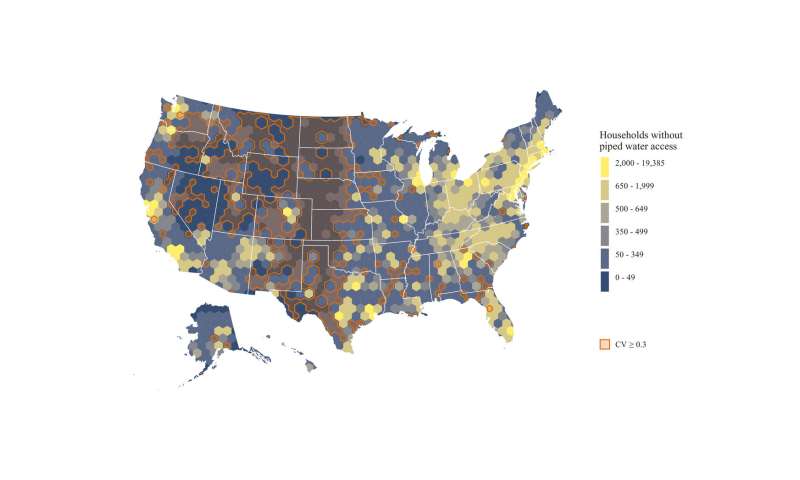Study shows over 1.1 million urban people in US live in homes without proper indoor plumbing
by Bob Yirka , Phys.org

Map of households without piped water access in the USA, 2013-2017. Note: lighter areas indicate areas with higher numbers of households without piped water. Clusters of plumbing exist in major cities and particular regions across the country. Credit: Katie Meehan.
A team of researchers from King's College London, the University of Arizona and ECONorthwest has found that an estimated 1.1 million urban people in the U.S. live in homes without proper indoor plumbing. In their paper published in Proceedings of the National Academy of Sciences, the group describes their analysis of census data for 50 of the largest metropolitan areas in the U.S. and what it showed them about people living without standard indoor plumbing and associated facilities.
In advanced countries such as the U.S., it is assumed that most people have basic amenities such as access to clean water and associated facilities. In this new effort, the researchers have found that is not the case for many people living in some of the biggest cities in the country. In reality, many people, especially minorities, are living without proper indoor plumbing facilities.
The work involved analyzing data obtained by the U.S. Census Bureau, the federal government entity responsible for carrying out nationwide surveys every 10 years. Wanting to know more about access to running water, the researchers focused on data from questions about whether people had access to "complete plumbing" which was described as residences that had both hot and cold running water piped into their home, along with at least one bath or shower. They found that for approximately 500,000 households in large urban areas, the answer was no.
In drilling down further into the data, the researchers found that such households accounted for approximately 1.1 million people. They also found a connection between the wealth gap of a given city and the number of people living without piped water. They found, for example, that percentage-wise, wealthy cities such as San Francisco, Portland and Austin had some of the highest rates of what they describe as plumbing poverty. In looking at sheer numbers, they found New York, Los Angeles and San Francisco had the most people living with plumbing poverty. They also found that race played a role. On average, black people were 35 percent more likely to be living with plumbing poverty than white people. They also found that plumbing poverty was most often found in rented facilities, particularly in mobile homes.
Explore further
A team of researchers from King's College London, the University of Arizona and ECONorthwest has found that an estimated 1.1 million urban people in the U.S. live in homes without proper indoor plumbing. In their paper published in Proceedings of the National Academy of Sciences, the group describes their analysis of census data for 50 of the largest metropolitan areas in the U.S. and what it showed them about people living without standard indoor plumbing and associated facilities.
In advanced countries such as the U.S., it is assumed that most people have basic amenities such as access to clean water and associated facilities. In this new effort, the researchers have found that is not the case for many people living in some of the biggest cities in the country. In reality, many people, especially minorities, are living without proper indoor plumbing facilities.
The work involved analyzing data obtained by the U.S. Census Bureau, the federal government entity responsible for carrying out nationwide surveys every 10 years. Wanting to know more about access to running water, the researchers focused on data from questions about whether people had access to "complete plumbing" which was described as residences that had both hot and cold running water piped into their home, along with at least one bath or shower. They found that for approximately 500,000 households in large urban areas, the answer was no.
In drilling down further into the data, the researchers found that such households accounted for approximately 1.1 million people. They also found a connection between the wealth gap of a given city and the number of people living without piped water. They found, for example, that percentage-wise, wealthy cities such as San Francisco, Portland and Austin had some of the highest rates of what they describe as plumbing poverty. In looking at sheer numbers, they found New York, Los Angeles and San Francisco had the most people living with plumbing poverty. They also found that race played a role. On average, black people were 35 percent more likely to be living with plumbing poverty than white people. They also found that plumbing poverty was most often found in rented facilities, particularly in mobile homes.
Explore further
More information: Meehan et al., Geographies of insecure water access and the housing–water nexus in US cities. Proceedings of the National Academy of Sciences (2020). DOI: 10.1073/pnas.2007361117
No comments:
Post a Comment